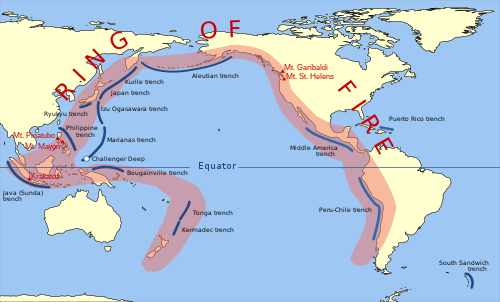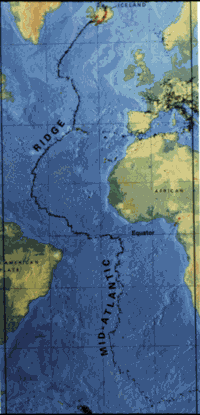High School Earth Science/Volcanic Activity
Everybody has heard of volcanoes—the angry Earth spewing up its wrath, the sudden explosion of a distant mountain top, and lava that slithers ominously toward villages. Volcanoes are fantastic displays of the power of the Earth. But what actually is a volcano? How and where are they formed? Why do some places have a history of volcanic activity? Volcanoes explain a key piece of the Earth's geologic puzzle (Figure 8.1).

Lesson Objectives
[edit | edit source]- Explain how volcanoes form.
- Describe places where volcanoes occur.
- Describe what volcanic hot spots are and where they occur.
How Volcanoes Form
[edit | edit source]
You have already learned about tectonic plates. Beneath the Earth's surface, powerful forces are at work. These forces move lithospheric plates and produce huge chambers of magma, molten rock beneath the Earth's crust. Like water that bursts from a tiny hole in a water pipe, the liquid magma seeks cracks or fissures in the Earth's crust through which it could flow. This is a volcano—an opening in the earth’s crust through which magma or gases can erupt onto the surface.
When molten rock escapes from beneath the Earth's surface, it changes from magma to lava, molten rock above the Earth's surface. Because the temperatures at the Earth's surface are much lower than in the magma chambers, the lava does not take long to solidify back into rock. As layer upon layer of lava solidifies, a mountain is formed (Figure 8.2).
As you can see in Figure 8.2, magma begins in the lava chamber and comes to the surface through the throat of the volcano. The volcano is constructed layer by layer, as ash and lava solidify, one upon the other. However, other types of volcanoes exist, and will be discussed later in this chapter.
Where Volcanoes Occur
[edit | edit source]Because volcanoes are vents for magma, it makes sense that volcanoes would be formed above underground magma chambers. If you recall, magma is molten rock that has been heated because of high temperatures and pressures beneath the Earth's crust. This pressure mostly occurs where the tectonic plates meet and subduct. Look at the map of tectonic plates in Figure 8.3.

So, volcanic activity tends to occur along subduction plate boundaries, where one plate slides underneath another. The edges of the Pacific Plate make up a long subduction boundary. There are a huge number of earthquakes along these boundaries, because these are regions where the plates are colliding. For the same reason, the majority of the volcanic activity on the Earth also occurs along these convergent boundaries. This is called the Pacific Ring of Fire where over 75% of the world's volcanoes are found. The Cascade Range of volcanoes runs through southwestern Canada and the Pacific Northwest of the United States. These volcanoes are the result of subduction of the Juan de Fuca plate beneath the North American plate (Figure 8.4).


Of course, this is not the only area where volcanoes occur. Beneath the ocean, there are also divergent boundaries, where tectonic plates are pulling away from each other. As the plates pull away from each other, they create a deep canyon or fissure on the sea floor through which molten rock escapes. Mid-ocean ridges, like the Mid-Atlantic ridge, form here as lava flows out through the fissure (Figure 8.5). Submarine volcanoes can also form on the ocean floor. At times these volcanoes can grow to create islands above the water's surface. This explains how Surtsey, a small island near Iceland formed (Figure 8.6).

Volcanic Hot Spots
[edit | edit source]Although most volcanic activity on Earth occurs at plate boundaries, there are some volcanically active spots that are in the middle of a tectonic plate. These areas are called hot spots. The islands of Hawaii formed over a hot spot and are not located on the Pacific Ring of Fire (Figure 8.7). The Hawaiian islands are the exposed peaks of a great chain of volcanoes that were formed over millions of years. The islands are thought to lie directly above a column of hot rock called a mantle plume. Mantle plumes are more or less fixed in place and continuously bring magma up from the mantle towards the crust. As the tectonic plates move above them, they leave a trail of volcanic activity, which forms island chains like Hawaii. Scientists believe there are about 50 hot spots on the Earth. Other hot spots include Yellowstone and the Galapagos Islands.

Don't confuse hot spot volcanoes with islands that are formed by plate tectonics like the Aleutian island chain in Alaska. These long lines of volcanoes form as the edge of a subducted plate melts, producing magma which rises to the surface along the edge of the plate. These volcanic mountains will all be about the same age. When islands form over a hot spot, the youngest island is over the hot spot. As you move along the island chain, each island further from the hot spot will be older than the one before it.
Lesson Summary
[edit | edit source]- Volcanoes form when magma reaches the Earth's surface.
- Volcanoes occur most often along plate boundaries.
- Convergent plate boundaries where oceanic crust is subducted form many of the volcanoes found on Earth.
- Divergent plate boundaries produce huge mountain ranges under water in every ocean basin.
- Volcanoes like those that form the islands of Hawaii form over areas called hot spots.
Review Questions
[edit | edit source]- What is the difference between magma and lava?
- Explain how volcanoes are formed.
- Why are there volcanoes along the west coast of the United States?
- Why do volcanoes occur where tectonic plates pull apart or diverge?
- Explain how the Pacific Ring of Fire got its name.
- What is a mantle plume?
- Suppose a new volcano suddenly formed in the middle of the United States. How might you explain what caused this volcano?
- Volcanoes have been found on Venus, Mars, and even Jupiter's moon Io. What do you think this indicates to planetary geologists?
Vocabulary
[edit | edit source]- fissure
- A long crack into the Earth's surface, from which lava erupts onto the surface.
- hot spot
- A fixed region of hot magma that rises through the mantle and creates volcanoes on the Earth's surface. A hot spot is above a mantle plume.
- lava
- Molten rock that has been erupted onto the Earth's surface. Magma becomes lava once it emerges on the surface.
- magma
- Molten rock found under the Earth's surface.
- mantle plume
- A column of very hot rock that rises up through the mantle. Mantle plumes will form hot spots if they make it all the way up to the surface of the Earth's crust.
Points to Consider
[edit | edit source]- When you look at the map of tectonic plates (Figure 8.3), what areas besides the Pacific Ring of Fire would you expect to have volcanic activity?
- Some volcanoes are extinct; they are no longer active and will probably never be again. What do you think causes a volcano to become extinct?
- Hot spots are still poorly understood by earth scientists. Given your understanding of the Earth's interior, why do you think it's hard to study hot spots?